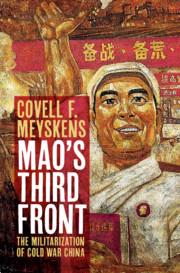Refine search
Actions for selected content:
15418 results in Military history
3 - Hitler’s Border Wars, 1938–1939
-
- Book:
- World War II
- Published online:
- 18 May 2020
- Print publication:
- 30 April 2020, pp 60-85
-
- Chapter
- Export citation
10 - The European Periphery, 1940–1944
-
- Book:
- World War II
- Published online:
- 18 May 2020
- Print publication:
- 30 April 2020, pp 234-259
-
- Chapter
- Export citation
Notes
-
- Book:
- World War II
- Published online:
- 18 May 2020
- Print publication:
- 30 April 2020, pp 381-386
-
- Chapter
- Export citation
1 - The World in 1937
-
- Book:
- World War II
- Published online:
- 18 May 2020
- Print publication:
- 30 April 2020, pp 8-41
-
- Chapter
- Export citation
Acknowledgements
-
- Book:
- World War II
- Published online:
- 18 May 2020
- Print publication:
- 30 April 2020, pp xvii-xvii
-
- Chapter
- Export citation
8 - Defending the Perimeter: Japan, 1942–1944
-
- Book:
- World War II
- Published online:
- 18 May 2020
- Print publication:
- 30 April 2020, pp 176-203
-
- Chapter
- Export citation
Boxes
-
- Book:
- World War II
- Published online:
- 18 May 2020
- Print publication:
- 30 April 2020, pp xi-xii
-
- Chapter
- Export citation
6 - The Red Army versus the Wehrmacht, 1942–1944
-
- Book:
- World War II
- Published online:
- 18 May 2020
- Print publication:
- 30 April 2020, pp 136-153
-
- Chapter
- Export citation
Introduction
-
- Book:
- World War II
- Published online:
- 18 May 2020
- Print publication:
- 30 April 2020, pp 0-7
-
- Chapter
- Export citation
2 - Japan and China, 1937–1940
-
- Book:
- World War II
- Published online:
- 18 May 2020
- Print publication:
- 30 April 2020, pp 42-59
-
- Chapter
- Export citation
7 - Japan’s Lunge for Empire, 1941–1942
-
- Book:
- World War II
- Published online:
- 18 May 2020
- Print publication:
- 30 April 2020, pp 154-175
-
- Chapter
- Export citation
5 - Wars of Ideology, 1941–1942
-
- Book:
- World War II
- Published online:
- 18 May 2020
- Print publication:
- 30 April 2020, pp 110-135
-
- Chapter
- Export citation
9 - The ‘World Ocean’ and Allied Victory, 1939–1945
-
- Book:
- World War II
- Published online:
- 18 May 2020
- Print publication:
- 30 April 2020, pp 204-233
-
- Chapter
- Export citation

Mao's Third Front
- The Militarization of Cold War China
-
- Published online:
- 24 April 2020
- Print publication:
- 14 May 2020
12 - Seigneurial Violence in Medieval Europe
- from Part III - Social, Interpersonal and Collective Violence
-
-
- Book:
- The Cambridge World History of Violence
- Published online:
- 13 March 2020
- Print publication:
- 26 March 2020, pp 248-266
-
- Chapter
- Export citation
Maps
-
- Book:
- The Cambridge World History of Violence
- Published online:
- 13 March 2020
- Print publication:
- 26 March 2020, pp xiv-xiv
-
- Chapter
- Export citation
Part II - Prehistoric and Ancient Warfare
-
- Book:
- The Cambridge World History of Violence
- Published online:
- 13 March 2020
- Print publication:
- 26 March 2020, pp 179-296
-
- Chapter
- Export citation
9 - Homicide in a Global Perspective: Between Marginalisation and Resurgence
- from Part II - Intimate and Gendered Violence
-
-
- Book:
- The Cambridge World History of Violence
- Published online:
- 13 March 2020
- Print publication:
- 26 March 2020, pp 187-206
-
- Chapter
- Export citation
Part II - Cultures of War and Violence
-
- Book:
- The Cambridge World History of Violence
- Published online:
- 13 March 2020
- Print publication:
- 26 March 2020, pp 117-216
-
- Chapter
- Export citation
27 - Criminal Violence and Culture in Europe
- from Part V - Representations and Constructions of Violence
-
-
- Book:
- The Cambridge World History of Violence
- Published online:
- 13 March 2020
- Print publication:
- 26 March 2020, pp 561-579
-
- Chapter
- Export citation
